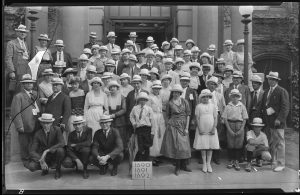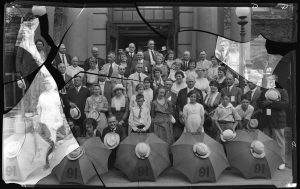Cellulose Nitrate film was first invented in 1887, patented in 1889, and hit the public market in 1902. With it came a paradigm shift in the realm of publicly accessible cinematography. Nitrate film was flexible, light, and could be strung together in long rolls allowing for multiple photos to be taken in a row. It required fewer solvents and film preparation techniques than glass plate film and could be prepared in a fraction of the time. By lowering the entry point to casual photography, this invention brought forward waves of new photographers ready to capture their world on film. With them came a wider variety of subjects matters to be photographed

By the turn of the century, cellulose nitrate films were practically the bread and butter of the Eastman Kodak corporation; they were industrially mass-produced, and this newly efficient system of film production brought filmography to the masses. In the first third of the 20th century, it really seemed as if nitrates were the future of photography!
However, nitrate film did come with one insignificant, teeny tiny, itsy bitsy, almost imperceptible downside: it sometimes explodes. Specifically its image content deteriorated quickly, and deteriorated nitrate film was prone to spontaneously combust and explode. The only effective way to prevent these explosions, like what happened to the 1937 Fox Vault, is to freeze the nitrate film at sub-zero temperatures. Most storage facilities for nitrate film, like that of the Chicago History Museum, are massive freezers that keep nitrate film meant prevent instant combustion.

The Chicago History Museum alone has reportedly 35,000 films on site and thus the protection of those films before they are digitized is essential. At the University of Illinois Archives–with our lack of space for a multi-million-dollar refrigeration unit–have opted to have our nitrate films digitized before their potential explosion dates. We are left today with thousands of photos in pure digital form, and we feel committed to giving them a name and a retelling story that the physical films once held.

The Nitrate Digitization Project, as we’ve come to call it, is part passion project and part dedication to the history contained here at the University Archives. So many of these films are from members of the community whose legacy is stored in thousands of JP_2 files online. Namely, over 500 of the files digitized were by just one guy! A Champaign-Urbana resident and photographer, Bernard Strauch documented so many early images of buildings on campus that exist today. Some of the images in the project were orchestrated and planned out. Strauch often took class reunion photos for some of the earliest graduating classes.

Where Strauch’s work truly shines is in his series of on-the-ground photos that capture a moment and were wholly unprompted. Whether it’s rushing to be on scene to see a derailed train just a day after the news broke, photographing all angles of a burned down church at what appears to be 6 in the morning, or even snagging photos of WWI general visiting campus, Strauch always made his mark with his images. So, we are seeking to do justice to Strauch’s work, and all those captured within the nitrate files, by reconstructing and retelling the stories captured almost a century ago. So, we hope to post bi-weekly ‘Tales from the Nitrate Negatives” as we can and work to dissect a world of the past both very alike, yet very alien from our own.